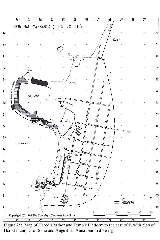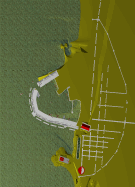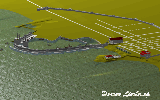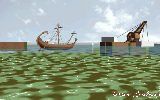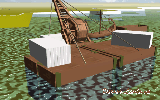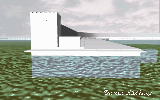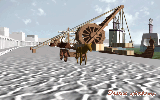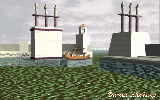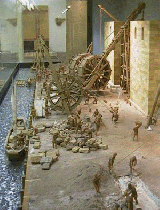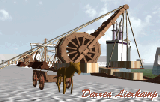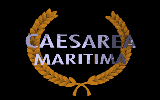


Construction of the Harbour Mole
|
Reference and plan Holum, K.G., Combined Caesarea Expeditions: 1998 Summer Season, retrieved December 18, 2001 from
http://www.digcaesarea.org/Documents/WWWrept.98.html
Reinhardt, E.G. 'The Single Mission Barges of Caesarea' "The problems associated with the site did not impede Herod or his engineers and he created an almost entirely 'man-made' harbour using mostly imported skills, material, and probably labour, within an incredibly short time. There can be little doubt that Roman specialists were called in to assist Herod on this project, for in order to build this harbour of over 200,000 sp. meters in little over a decade (c21-10 BCE), all the ingenuity of Roman engineering techniques were employed including the extensive use of hydraulic concrete made with pozzolana. Even so, to achieve what they did within the time scale, it would have been hypothesized that 'construction islands' were formed along the length of the main breakwater from which the mole could be extended concurrently. In order to create these 'islands', materials had to be shipped to the site in sizeable amounts in seaworthy containers, deposited on the seabed, and rapidly consolidated"(3). "However, there are problems associated with this as Israel's mediterranean coastline can be subject to heavy swells even in good weather, and it must be remembered that the sea was considerably shallower then than it is now (3m as opposed to 7-8m), which would have given rise to breaking seas. The Roman Engineers achieved this at Sebastos by building large floating caissons within which they could ship a quantity of set concrete to pre-designated sites and sink them in place by adding more concrete and thereby creating large pad foundations for the spine wall"(3). The upper part of the mole as constructed by building two walls ontop of the foundation material, not very high above sealevel, and letting the wave action fill the space inbetween the walls with silt. This was then capped with ashlar paving stones to build the promenade (2). The incredible width of the promenade (according to Josephus, 100 feet) makes me think that this width was needed in order to accomodate Roman cranes, which would have been used in the loading and unloading of vessels moored alongside the promenade. Additional to the area required for the Horrea and boarding facilities that lined the wall. (2) Retrieved 18/12/01 from Holum, K.G., Combined Caesarea Expeditions: 1998 Summer Season, retrieved December 18, 2001 from
http://www.digcaesarea.org/Documents/WWWrept.98.html |


|

